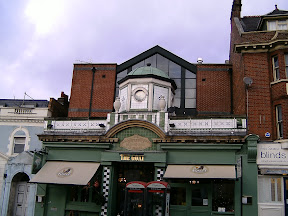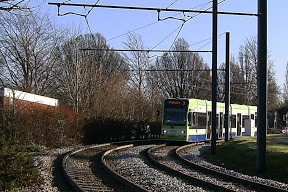18 December, 2012
Battersea
Nell Dunn slummed it in Battersea. She crossed the river and made it the subject of her 1963 book 'Up the Junction' which documents the working class lives she shared at least in her fiction. And who can forget Dennis Waterman in the film version? Not me that's for sure. Nell Dunn seems to have brought the whole of Chelsea over with her in the fifty years since her book was published. Battersea has gone posh!
Now it's full of shops, some of them with an extraordinary degree of specialisation: I went into one called 'the honey shop' that just sells products made by bees, and derived from them. Not sure many bees produce flower pots with beeswax candles in though. The main merit of Battersea is a shopping centre, with some strange specialist shops selling at premium prices. I couldn't find a pound shop here. There are also lots of restaurants, although not the restaurants that, together with barber shops makes one think that a neighbourhood has been colonised by unskilled workers from overseas. These are the type of restaurants found in posh shopping centres. This pub used to be the Temperance Billiard Hall - with 17 tables no less.
 To be truthfull Battersea has its cultural side too. There is the Battersea Arts Centre in the former Battersea Hown Hall. The building has some original features like a bee mosaic on the floor and the Ayes and Noes lobbies in the former Council Chamber. I once spent a never to be forgotten night there watching an opera about Dennis Neilsen and his murderous ways. There was no interval because nobody would have come back.
To be truthfull Battersea has its cultural side too. There is the Battersea Arts Centre in the former Battersea Hown Hall. The building has some original features like a bee mosaic on the floor and the Ayes and Noes lobbies in the former Council Chamber. I once spent a never to be forgotten night there watching an opera about Dennis Neilsen and his murderous ways. There was no interval because nobody would have come back.
 The library is also rather splendid, at least the 1924 extension in the Arts and Crafts style. It's also worth going into to see the woodwork around the reference library, although this is not well cared for.
The library is also rather splendid, at least the 1924 extension in the Arts and Crafts style. It's also worth going into to see the woodwork around the reference library, although this is not well cared for.
 So Battersea is posh, but you'll still find an Asda. Maybe not quite as posh as we thought.
So Battersea is posh, but you'll still find an Asda. Maybe not quite as posh as we thought.
15 December, 2012
Larkhall, Lambeth
13 December, 2012
Horniman museum christmas
Hooligan crafts made out of rubbish and mulled wine laced with rum. A visit to the Horniman museum and Gardens to see their exhibition The adorned body, one of the london 2012 Stories of the World, and to take part in their Christmas Fair. The Christmas fair was busy and so was the museum on a cold but bright winters day. The mulled wine was very good but the crafts were the usual suspects. Everything recycled and not as good as factory made things.
 The Horiman museum was given to Londoners by a tea producer for their recreation, instruction and enjoyment as a free museum, and he adds the words 'for ever'. With care it should last that long. The collection is quite eclectic with anthropology, music and natural history coming to the fore. The torture chair is always a favourite of mine and if I take a visitor there I head for that. This time I was on my own so after the briefest glance at this terrible instrument I made for The Body Adorned. The exhibition was perhaps a bit too crowded. The Horniman really pitches itself to the pushchair and toddler market which all adds to the congestion. And what the mother was thinking about taking a picture of her child next to a video wall I don't know. Seems an odd thing to do.
Nevertheless the exhibition was good and fun to go to with lots of video of people making fashion staatements. I think I need to go when it's quieter.
The views over London from the gardens are spectacular. This is the Overhill Estate also known as Dawson Heights.
The Horiman museum was given to Londoners by a tea producer for their recreation, instruction and enjoyment as a free museum, and he adds the words 'for ever'. With care it should last that long. The collection is quite eclectic with anthropology, music and natural history coming to the fore. The torture chair is always a favourite of mine and if I take a visitor there I head for that. This time I was on my own so after the briefest glance at this terrible instrument I made for The Body Adorned. The exhibition was perhaps a bit too crowded. The Horniman really pitches itself to the pushchair and toddler market which all adds to the congestion. And what the mother was thinking about taking a picture of her child next to a video wall I don't know. Seems an odd thing to do.
Nevertheless the exhibition was good and fun to go to with lots of video of people making fashion staatements. I think I need to go when it's quieter.
The views over London from the gardens are spectacular. This is the Overhill Estate also known as Dawson Heights.

09 December, 2012
Addington Old and New
By tramcar to the countryside! You can get to New Addington by one of the Croydon tramcars, although I've now done it so you don't have to.
 There's nothing much at New Addington, it's a big council estate and if a person I know is to be believed with a dubious reputation. It didn't look that bad to me but I stayed on the beaten path from the tramcar terminus to the Church of St Edward the Confessor, built around 1957.
There's nothing much at New Addington, it's a big council estate and if a person I know is to be believed with a dubious reputation. It didn't look that bad to me but I stayed on the beaten path from the tramcar terminus to the Church of St Edward the Confessor, built around 1957.
 The church has a microbrewery attatched. If I'd known that I would have called at the vicarage!
New Addington has a library, leisure centre, nursery and community centre, presumably because it is so far out of Croydon. I never thought that Croydon had any rural districts.
Old Addington is not what you would call a pretty village. True it has an old forge which is the only forge operating now in the Croydon District, and don't forget that Croydon also once made some very fine Church Bells by Gillet and Johnson.
The church has a microbrewery attatched. If I'd known that I would have called at the vicarage!
New Addington has a library, leisure centre, nursery and community centre, presumably because it is so far out of Croydon. I never thought that Croydon had any rural districts.
Old Addington is not what you would call a pretty village. True it has an old forge which is the only forge operating now in the Croydon District, and don't forget that Croydon also once made some very fine Church Bells by Gillet and Johnson.
 The glory of Addington is the church of St Mary dating from just after the conquest. It's slightly cagey vicar needed to have a good look at me before she would let me in but I must have reassured her that I would not run off with the poor box.
The glory of Addington is the church of St Mary dating from just after the conquest. It's slightly cagey vicar needed to have a good look at me before she would let me in but I must have reassured her that I would not run off with the poor box.
 The chancel is the oldest part of this little flint church and was decorated with very impressive medieval style wall paintings in memory of Archbishop Benson of Canterbury, who was the father of E F Benson of Mapp and Lucia fame. The chancel has three little romanesque windows and a great big vulgar urn to a former lord mayor of London.
The Archbishops of Canterbury used Addington Palace as a summer residence from the time of Archbishop Manners-Sutton (1805 to 1828) until Archbishop Frederick Temple, father of William Temple, decided he preferred a residence in Canterbury in 1897. As a consequence of their residence there are five Archbishops of Canterbury buried in this church.
So the Addingtons made a morning out rather than a day.
The chancel is the oldest part of this little flint church and was decorated with very impressive medieval style wall paintings in memory of Archbishop Benson of Canterbury, who was the father of E F Benson of Mapp and Lucia fame. The chancel has three little romanesque windows and a great big vulgar urn to a former lord mayor of London.
The Archbishops of Canterbury used Addington Palace as a summer residence from the time of Archbishop Manners-Sutton (1805 to 1828) until Archbishop Frederick Temple, father of William Temple, decided he preferred a residence in Canterbury in 1897. As a consequence of their residence there are five Archbishops of Canterbury buried in this church.
So the Addingtons made a morning out rather than a day.
Subscribe to:
Posts (Atom)

